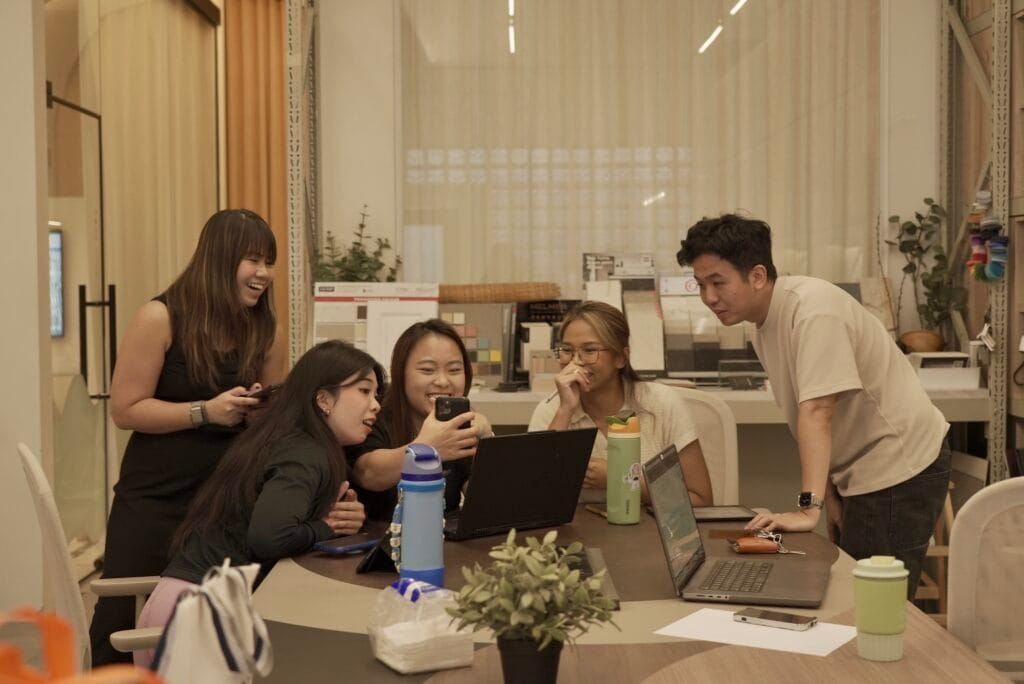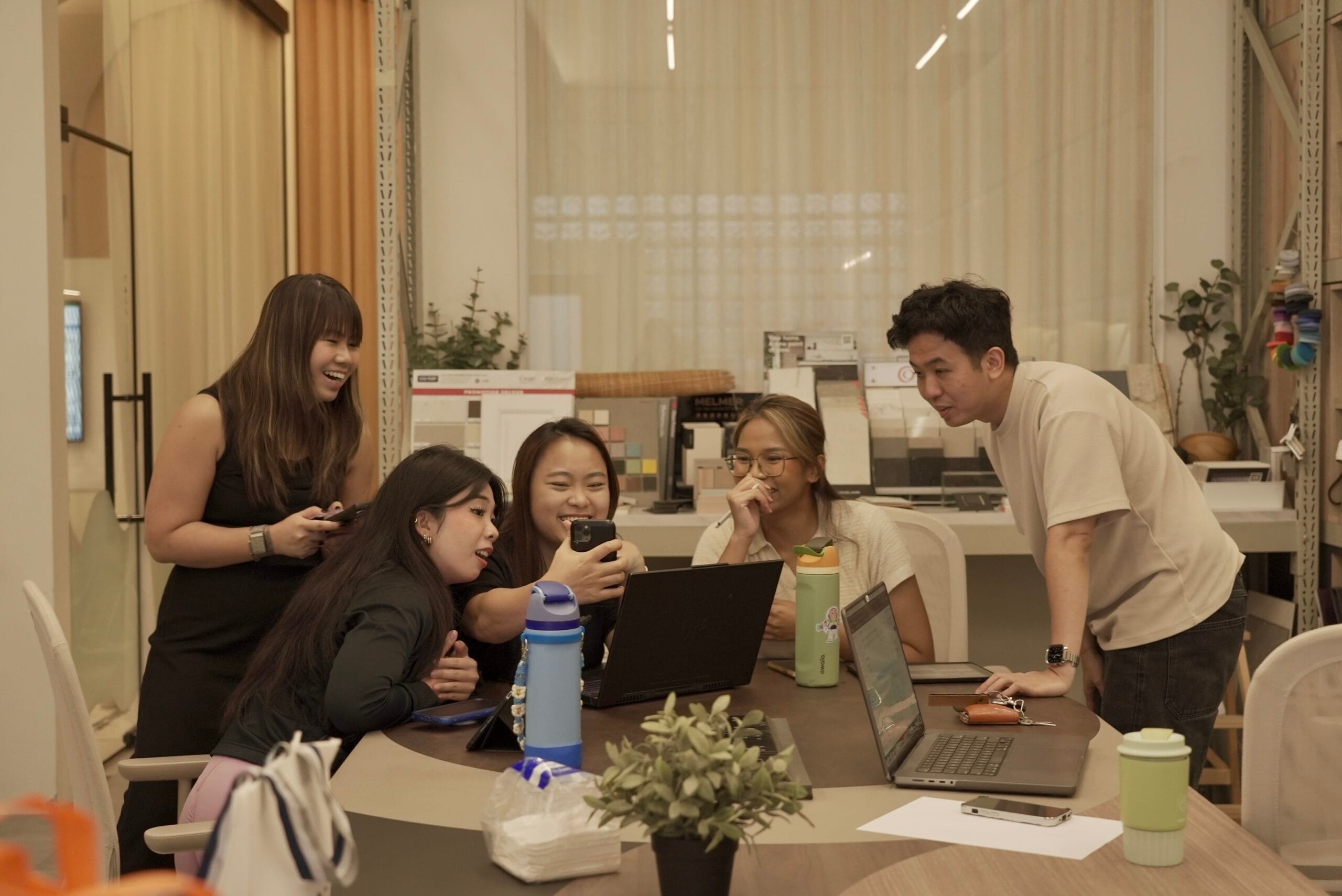AI and Interior Design in Singapore: What We’ve Learned After Two Years
Two years ago, we asked: “Will AI create awesome interiors?”
Back then, the buzz was deafening. Loads of people were convinced that artificial intelligence would soon inspire, design, quote, and through robotics, possibly even build homes better than humans could.
Fast forward to 2025—and here we are. Still designing. Still building. Still human.
But something has definitely changed. AI didn’t take our jobs. Instead, it gave us something unexpected: more focused conversations with homeowners, faster explorations of ideas, and honestly, a reminder of why the human side of design matters more than ever.
Here’s what we’ve learned.
Why That First Article Aged Well
Back in 2023 there was significant talk of AI potentially displacing design roles within a few years. We didn’t buy it.
Instead, we bet on the opposite: that the spaces people love are built on trust, not tech.
Fast forward to today: AI can generate jaw-dropping visuals in seconds. But trust?
Trust is scarcer and more critical than ever before.
Today, generative tools like Midjourney or Google’s image‑models let you whip up polished visual concepts in minutes, sometimes seconds! But ‘good looking’ isn’t the same as build‑ready.
What Actually Creates Trust (And Why It’s Still Everything)
Every week, someone pitches us the next big AI tool for interior design, marketing or sales.
One company wanted us to use a chatbot that would “proactively call” our past clients for upselling. Another proposed replacing our first design consultations with an AI voice agent that could “extract more accurate data.”
I asked one of them, half-jokingly: “If your AI builds trust so well, why didn’t it make this sales call instead of you?”
They laughed. Then admitted they preferred speaking to a human.
So do we. So do our clients.
Here’s what we’ve learned builds trust faster than any automation:
A warm hello. Someone who remembers your name and that you mentioned your kids love to bake.
A patient ear. Time to understand that “modern minimalist” doesn’t mean the same thing to you as it does to the last ten clients.
Quiet confidence. The feeling that someone truly cares about people, not just their profits.
In Singapore’s crowded interior design scene, where firms appear overnight and vanish just as quickly, trust is the real differentiator.
At BuildBuilt, trust isn’t built through clever technology. It’s built through:
- Clear process: You know what’s happening and when.
- Empathy: We want a genuine relationship with you. We slow down to understand your life, not just your layout.
- Competence: We do what we promise, with care.
So whenever someone pitches us a new AI tool, we ask one question: “Will this help our clients trust us more?”
If the answer’s no, it stays on the shelf.
AI Hasn’t Replaced Creativity… It’s ‘Redistributed Confidence’
Two years ago, we half-joked that AI might design better than us someday.
Now we see it differently.
AI hasn’t replaced creativity. It’s redistributed confidence.
It’s given homeowners the courage to explore ideas that once required expensive software or professional visualization skills. With a few prompts in Midjourney or ChatGPT, anyone can now produce beautiful interior concepts in seconds.
Young designers who couldn’t afford 3D rendering software? They can now compete on ideas, not just budgets.
Homeowners who felt intimidated by design terminology? They can now walk into consultations with mood boards and preferences already formed.
This is genuinely exciting. It democratizes access to design thinking.
But here’s where it gets tricky.
When Beautiful Becomes Dangerous
Look at this render we created using Google’s Gemini Nano model:

It shows a serene HDB. Elegant. Calm. Believable.
Except for one thing: it’s kinda unsafe, infringing on illegal.
Under Singapore’s HDB safety regulations, built-in platforms or beds beside windows aren’t allowed without proper safety barriers. A homeowner might love this image enough to build it, only to face rejection during inspection. Or worse, build it without permits and face consequences later.
AI can create plausible dreams. It can’t create buildable realities.
This is the gap that’s widened over the past two years. AI has made it easier than ever to visualize what you want. But it hasn’t made it any easier to understand what’s actually possible in your specific flat, under Singapore’s specific regulations, within your specific budget.
That’s where human designers and project managers come in.. they translate what looks beautiful into what works safely, legally, and practically.
AI has changed access to ideas, not access to execution. Homeowners see more possibilities. Designers need to think deeper about constraints.
The gap between imagination and reality is narrower than ever, but the human touch has become even more valuable.
How Homeowners Are Actually Using AI (And What It Means)
AI has quietly entered daily life in ways that feel almost mundane now.
You can ask ChatGPT or Google Gemini for renovation advice while having your morning coffee. You can upload a photo of your living room into IKEA Kreativ and see it restyled with new furniture—all in seconds.
For many homeowners, this feels empowering. And it should! AI gives you a sense of control over your renovation before it even begins.
But empowerment can sometimes shade into overconfidence.
A render doesn’t tell you if your wall hides a structural beam. It can’t smell paint fumes, sense humidity, or predict how afternoon sunlight moves through your windows at 4pm. It doesn’t know that your downstairs neighbor has already complained twice about noise, so that jamming studio you’re planning might cause problems.
AI helps homeowners see possibilities. It doesn’t help them understand constraints.
Still, this shift is mostly healthy.
Increasingly, clients arrive with mood boards, Pinterest boards or AI‑generated visuals. This means our work shifts earlier: from finding style to making it real.
That’s progress.
The conversation becomes clearer. Less time spent on “what style do you prefer” and more time on “here’s how we adapt that style to your flat’s structure, your family’s lifestyle, and your budget.”
AI hasn’t replaced designers. It’s made the conversation start from a better place. It turns hesitation into better collaboration.
How Designers Are Using AI (And What’s Really Changed)
For professionals, AI has evolved from novelty to workflow companion.
Emerging workflow tools (AI‑enabled layout modules, rapid visualization engines) help us test multiple options faster. But they still require human review.
Creative platforms like Adobe Firefly 3, Midjourney, and Runway Gen-3 let us translate text prompts into mood boards or photorealistic render variations in minutes instead of hours.
And yes, we all use ChatGPT or Gemini to summarize design briefs, understand building codes, draft specification documents, or prepare presentation slides faster than ever before.
These tools are genuinely useful. But they don’t design with conviction.
Design is still about understanding emotion. It’s about interpreting what someone means when they say a room should feel “warm” or “elegant” or “homey.” It’s about standing in a half-lit living room and noticing that something feels off… maybe by just a few degrees of lighting temperature or a slightly wrong furniture scale.
AI can draw. It can’t feel. AI can copy and some stuff looks original. But we know that it didn’t come from heart. The conviction is lacking.
Ironically, AI has made design work more human, not less.
When everyone can generate a beautiful render, what clients actually look for is conviction in taste, judgment, and empathy. They’re not buying drawings, they’re investing in a real, human partnership.
At BuildBuilt, we use AI for iteration, not design automation. It helps us think faster and explore more options. But it never decides what a home should feel like. That’s still our job… and yours! if you’re the one living there.
The New Definition of Competence
If AI can generate layouts, create realistic images, and even research building regulations, what does competence mean today?
We believe competence has evolved from execution to ‘discernment’.
Technology can make us efficient. But discernment, the wisdom to know when to rely on it and when to lead with intuition, has become the designer’s most vital skill, next to ‘observation’.
Competence today means:
- Knowing which AI results to trust, and which to discard. Just because an AI layout looks interesting doesn’t mean it respects your flat’s structural layout or makes sense for how you actually live.
- Translating digital visuals into materials that age well. That white marble floor in the AI render? Beautiful. But with your family’s lifestyle? Let’s talk about alternatives that look similar but perform better.
- Guiding clients through decisions that balance beauty, safety, and comfort. Sometimes the most beautiful option isn’t the most practical. Competence is explaining the trade-offs clearly, without making clients feel stupid for asking.
- Using technology responsibly, without losing humanity. AI is a tool in our hands, not a replacement for our judgment.
The best designers today aren’t the fastest at generating renders. They’re the most discerning at knowing what actually matters.
They learn new tools with curiosity but stay anchored in timeless principles: proportion, light, ergonomics, emotion, and how spaces make people feel when they’re tired at the end of a long day.
AI may raise the baseline of speed. But humans still define what quality feels like.
BuildBuilt’s Perspective: Still Building With Humans
At BuildBuilt, we’re not anti-AI. We’re pro-human.
Our SPACE values guide how we integrate any new tool:
- Service: AI should make your experience smoother, not colder. If a tool distances us from you, we don’t use it.
- Purpose: Every tool we adopt must solve a real problem. We’re not interested in technology for technology’s sake.
- Authenticity: We stay transparent about what AI can and can’t do. If we use AI to generate initial concept renders, we tell you. If we think your AI-generated idea won’t work in reality, we tell you that too.
- Create Value: Technology should add clarity or comfort to your renovation journey, not confusion or overwhelm.
- Empathy: Machines calculate. Humans care. We choose empathy every time.
So when consultants pitch AI that can auto-call clients or run full sales funnels, we pause. Not because we fear automation, but because we care about first impressions and respect relationships.
The sound of a human voice still matters. A visit to your home still matters. Remembering that you mentioned your mother-in-law visits every weekend, so the guest room needs to feel welcoming… that still matters.
AI has changed the tools we hold. It hasn’t changed the values that hold us together.

What We’ve Learned: The Story So Far
After two years of watching AI evolve in interior design, here’s what we know:
1. AI didn’t steal our work, but reshaped it.
Early-stage design is faster now. Homeowners arrive more informed. But empathy has become rarer, and therefore more precious. The firms that thrive aren’t the ones with the best AI tools. They’re the ones that make clients feel understood.
2. Homeowners gained confidence, not mastery.
AI helps you visualize ideas you couldn’t before. But visualization isn’t the same as understanding practicality, feasibility, safety, or compliance. You still need someone who knows what can actually be built in your home.
3. Designers gained clarity.
With AI handling repetitive tasks (generating layout variations, producing mood boards, drafting specifications) we can return to what we do best: storytelling, craft, and care. The creative parts of design are more accessible now, not less.
4. Trust remains the real differentiator.
No algorithm can replace the feeling of being truly understood. In a world where everyone has access to the same AI tools, trust is the competitive edge. It’s built through consistency, transparency, and showing up when things go wrong.
5. Discernment is the new skill.
In the age of abundant information and instant renders, knowing when not to use a tool is just as important as knowing how to use it. The ability to filter, evaluate, and apply judgment is what clients pay for now.
6. The future belongs to partnerships.
AI and humans aren’t competitors. They complement each other. But make no mistake: empathy, not efficiency, will decide which design firms thrive in the next decade.
A Conversation, Not a Sales Pitch
If you’ve been exploring AI tools to visualize your dream home, we’d love to chat! human to human, of course.
Maybe you’ve created renders in Midjourney that you’re excited about. Maybe you’ve asked ChatGPT for renovation advice and got some helpful ideas. Maybe you’re just curious what’s actually possible in your HDB flat or condo.
Our team can help you translate what AI shows you into something that can actually be built, lived in, and loved. We’ll tell you what works, what doesn’t, and why.
We’ll bring the coffee. You bring your ideas! AI-generated or otherwise.
Book a Consultation — Let’s explore what’s possible together.
Questions We Hear Often
Does BuildBuilt use AI in your design process?
Yes, selectively. We use AI tools to ideate, exploring material variations, and testing ideas quickly. But every final design is refined, reality-checked, and approved by our very human team. AI helps us think faster, but it surely doesn’t replace our thinking.
Can homeowners rely entirely on AI for renovation planning?
No. AI tools don’t account for your flat’s specific structural conditions, Singapore’s safety regulations, or local building codes that change regularly. They can’t predict how materials perform in our tropical climate or spot potential problems before they become expensive mistakes.
Always consult a qualified designer and project manager before construction begins. The few hundred dollars for professional advice can save you tens of thousands in corrections later.
Will AI replace interior designers?
Unlikely for now, at least not in the way people feared two years ago.
AI assists with speed and visuals. But design is still deeply relational. Clients choose designers based on empathy, trust, and accountability. These qualities that can’t be automated.
As AI makes the technical parts easier, the human parts become more valuable, not less.
What’s BuildBuilt’s advantage in the AI era?
Honestly? Process clarity and empathy.
We use technology thoughtfully to serve you better. But we keep people and trust at the center of everything we do. When things go wrong (and in construction, things always go wrong at some point), you’ll have humans who care about solving the problem, not an algorithm pointing you to a FAQ page.
In a world where AI makes design more accessible, we believe the real value is in the relationship, not just the renders.









